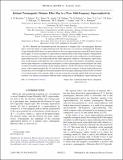Intrinsic paramagnetic Meissner effect due to s-wave odd-frequency superconductivity
Abstract
In 1933, Meissner and Ochsenfeld reported the expulsion of magnetic flux-the diamagnetic Meissner effect-from the interior of superconducting lead. This discovery was crucial in formulating the Bardeen-Cooper-Schrieffer (BCS) theory of superconductivity. In exotic superconducting systems BCS theory does not strictly apply. A classical example is a superconductor-magnet hybrid system where magnetic ordering breaks time-reversal symmetry of the superconducting condensate and results in the stabilization of an odd-frequency superconducting state. It has been predicted that under appropriate conditions, odd-frequency superconductivity should manifest in the Meissner state as fluctuations in the sign of the magnetic susceptibility, meaning that the superconductivity can either repel (diamagnetic) or attract (paramagnetic) external magnetic flux. Here, we report local probe measurements of faint magnetic fields in a Au=Ho=Nb trilayer system using low-energy muons, where antiferromagnetic Ho (4.5 nm) breaks time-reversal symmetry of the proximity-induced pair correlations in Au. From depth-resolved measurements below the superconducting transition of Nb, we observe a local enhancement of the magnetic field in Au that exceeds the externally applied field, thus proving the existence of an intrinsic paramagnetic Meissner effect arising from an odd-frequency superconducting state.
Citation
Di Bernardo , A , Salman , Z , Wang , X L , Amado , M , Egilmez , M , Flokstra , M G , Suter , A , Lee , S L , Zhao , J H , Prokscha , T , Morenzoni , E , Blamire , M G , Linder , J & Robinson , J W A 2015 , ' Intrinsic paramagnetic Meissner effect due to s -wave odd-frequency superconductivity ' , Physical Review X , vol. 5 , no. 4 , 041021 . https://doi.org/10.1103/PhysRevX.5.041021
Publication
Physical Review X
Status
Peer reviewed
ISSN
2160-3308Type
Journal article
Collections
Items in the St Andrews Research Repository are protected by copyright, with all rights reserved, unless otherwise indicated.

